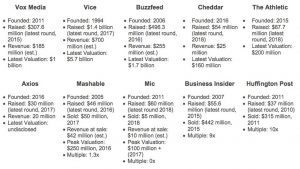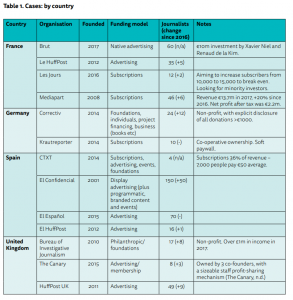This week we will be reviewing in the blog the business and editorial strategies of digital media companies. Recently, the digital media company Mic laid off most of its staff. This illustrates the risk of using an ad-support business model that media companies face. Digital media companies are valued depending on their growth expectations for revenue and profit. They are faced with losses and layoffs when they fail to meet these expectations.
An overview of revenue and valuations of mostly U.S. based digital media companies:
The Correspondent
The Correspondent has raised $2 million in a crowdfunding campaign for a U.S. version of its member-funded, ad-free digital news site. The goal is to reach $2.5 million by December 14. “That is our do or die goal,” said Rob Wijnberg, founder of The Correspondent. The Dutch version of The Correspondent, called De Correspondent, set a crowdfunding world record in 2013 by raising $1.7 million from 19,000 backers. Today, 61,000 members of De Correspondent support 21 full-time journalists in their mission to inform readers about “the most important developments and underlying forces that shape our world” (The Correspondent website).
That the business model of De Correspondent is working in the Netherlands is not the most exciting part. What makes the Correspondent unique are its founding principles. The Correspondent does not take advertising dollars of any kind. There are no sponsored articles, no annoying ads that break the user experience or selling of users’ data to any third party.
Readers of the Correspondent are called members. In order to read articles, readers pay what they feel they can afford. Journalists of the Correspondent are expected to spend 30 to 40 percent of their time interacting with members. The goal of this is to create a reader-journalist community wherein journalists share their story ideas and knowledgeable members share their expertise with the journalist.
Reuters Study
How does the Correspondent fit in the larger context of digital-born news sites? A 3-year Reuters study tracked 13 digital-born news outlets from the UK, France, Germany, and Spain. Eight of them rely on advertising as a major source of income. Still, there is an increasing sense that the public is willing to pay for news consumption. The Reuters study found that six news organization are generating revenue through subscriptions or membership models.
News organizations find themselves in a difficult funding environment and they continue to search for sustainable business models. Though there have been some high profile failures, none of our case-study news organizations closed since the beginning of the study in 2016. In fact, several organizations significantly expanded the newsrooms.
Compared to other digital markets, digital news media cannot chase exponential growth with large network effects. This is especially true for news media in languages other than English. Mediapart, a subscriber based French organization, notes that: ‘“Every year we ask ourselves: Will we grow again by 10,000 subscribers next year, and then the following year again?” “Trees do not rise to heaven.”’ The result of limited opportunity for scalability and challenges in the advertising market is that organizations use lean business models that depend on a variety of funding sources. Generally speaking, organizations focussed on scale rely more advertising revenue and niche outlets with specialized coverage tend to depend more on direct revenue from readers.
Media organizations need to build their audiences in order to achieve their financial and journalistic goals. Changes in Facebook’s algorithms had a mixed impact on the news media in the Reuters case-study. Overall, they consider traffic from social media sources to be a calculated risk and they are now placing a higher premium on direct traffic.
The Reuters study reports that in contrast to so-called, clickbait content, there is among the news media a flight to quality journalism. It may be obvious that media driven by subscription and donation models are rewarded more by focussing on publishing quality content rather than increasing page views. However, the Reuters study also finds that some media, such as the HuffPost UK, now also move away from a purely volume-driven strategy.
Relatedly, news media aim to widen their audience base by tapping into non-traditional audiences. Non-traditional audiences include those persons who are not well-off, well-educated or those who live outside of major urban areas. Journalists have been using social media such as Facebook and WhatsApp groups to bridge the social divide between them and underserved segments of the population. As Polly Curtis of the HuffPost UK pointed out on Facebook groups: ‘“It probably had a role in the fact that we sustained our growth of audience in Birmingham.” “The group there grew 500 members in a week.” “Digital is at its best when it’s as close to its audience as possible.”’
Further Reading
Mic has laid off the majority of its staff
A Dutch news startup has crowdfunded $1 million to ‘unbreak’ U.S. news
Coming of Age: Developments in Digital-Born News Media in Europe – Reuters

